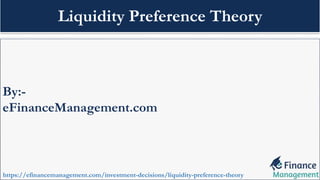Liquidity Preference Theory
•Télécharger en tant que PPTX, PDF•
1 j'aime•2,364 vues
The Liquidity Preference Theory suggests that investors demand higher interest rates for longer term investments because cash is considered the most liquid asset. There are three motives for demanding money: transaction motives for daily needs, precautionary motives for unexpected events, and speculative motives based on interest rate fluctuations. The total demand for money is the sum of these three motives and is determined by income and interest rates. Interest rates are set by the point where the total demand for money equals the fixed money supply as determined by the central bank, with the demand curve sloping downward and the supply curve being vertical.
Signaler
Partager
Signaler
Partager

Recommandé
Contenu connexe
Tendances
Tendances (20)
Similaire à Liquidity Preference Theory
Similaire à Liquidity Preference Theory (20)
Keynes liquidity preference theory of interest rates and income determination

Keynes liquidity preference theory of interest rates and income determination
Plus de efinancemanagement.com
Plus de efinancemanagement.com (20)
Dernier
This presentation was provided by William Mattingly of the Smithsonian Institution, during the fourth segment of the NISO training series "AI & Prompt Design." Session Four: Structured Data and Assistants, was held on April 25, 2024.Mattingly "AI & Prompt Design: Structured Data, Assistants, & RAG"

Mattingly "AI & Prompt Design: Structured Data, Assistants, & RAG"National Information Standards Organization (NISO)
Dernier (20)
SECOND SEMESTER TOPIC COVERAGE SY 2023-2024 Trends, Networks, and Critical Th...

SECOND SEMESTER TOPIC COVERAGE SY 2023-2024 Trends, Networks, and Critical Th...
Mattingly "AI & Prompt Design: Structured Data, Assistants, & RAG"

Mattingly "AI & Prompt Design: Structured Data, Assistants, & RAG"
Mixin Classes in Odoo 17 How to Extend Models Using Mixin Classes

Mixin Classes in Odoo 17 How to Extend Models Using Mixin Classes
Unit-IV; Professional Sales Representative (PSR).pptx

Unit-IV; Professional Sales Representative (PSR).pptx
Basic Civil Engineering first year Notes- Chapter 4 Building.pptx

Basic Civil Engineering first year Notes- Chapter 4 Building.pptx
Unit-V; Pricing (Pharma Marketing Management).pptx

Unit-V; Pricing (Pharma Marketing Management).pptx
This PowerPoint helps students to consider the concept of infinity.

This PowerPoint helps students to consider the concept of infinity.
Liquidity Preference Theory
- 2. 1. Introduction 2. Demand for Money 3. Total Demand 4. Supply for Money 5. Determination of Interest Rate 6. Limitations 7. Reference Content
- 3. Liquidity Preference Theory suggests that investors demand higher interest rates or additional premiums for medium or long-term maturities and investments. Simply put, interest rates directly indicate the price of the money. Therefore, other things remaining constant demand and supply of money determines the interest rate. According to Keynes, interest rates are a reward for not having liquidity in their hands, and the consideration goes hand in hand with the ideology that cash is the most liquid asset. Introduction
- 4. There are 3 main reasons (motives) for demand for money. These motives are as follows: 1. Transaction Motives: In order to satisfy all daily needs, the individual requires money with a transaction motive. Demand through transaction motive is inelastic to interest rates and elastic to income level. Expression of transaction motive is: T = f (Y) 2. Precautionary Motives: This is the second motive. Because the future is uncertain and there could be sudden natural or man-made disasters, Individuals demand money with a precautionary motive for protection against uncertain future. Expression of precautionary motive is: P = f (Y) 3. Speculative Motive: Individuals demand money by taking into account fluctuations in interest rates or bond prices. If interest rates are lower or bond prices are lower, there is a high demand for money with speculative motives and vice versa. Expression of speculative motive is: S = f (R) Demand for Money
- 5. The aggregate demand for money or the function of liquidity preference would be the sum of all three motives transaction, precautionary and speculative. TD = T + P + S TD = f (Y) + f (Y) = f (R) Total Demand = f (Y, R) Total Demand
- 6. According to John Maynard Keynes, the supply of money is largely fixed and determined by the country’s central bank. Hence, according to the theory of liquidity preference, the supply is perfectly inelastic and graphically represents a straight vertical line. Supply for Money
- 7. The interest rate is determined at the point where the demand for money is equal to the supply of money. The TD curve is downward sloping from left to right. This is due to the opposite link between the demand for money and the interest rate. Whereas the Supply (SP) curve is perfectly inelastic and represents a vertical straight line. Determination of Interest Rate
- 8. The limitations of Liquidity Preference Theory are as follows: • It assumes that the employment rate is constant. • It assumes a certain level of income. • It completely ignores the scenario of receiving interest benefits for some funds and receiving liquidity benefits for remaining funds. • Ignores that different interest rates exist in different markets at the same time. • The savings done by individuals is not considered Limitations
- 9. Reference To know more about it, click on the link given below: https://efinancemanagement.com/investment-decisions/liquidity-preference-theory
